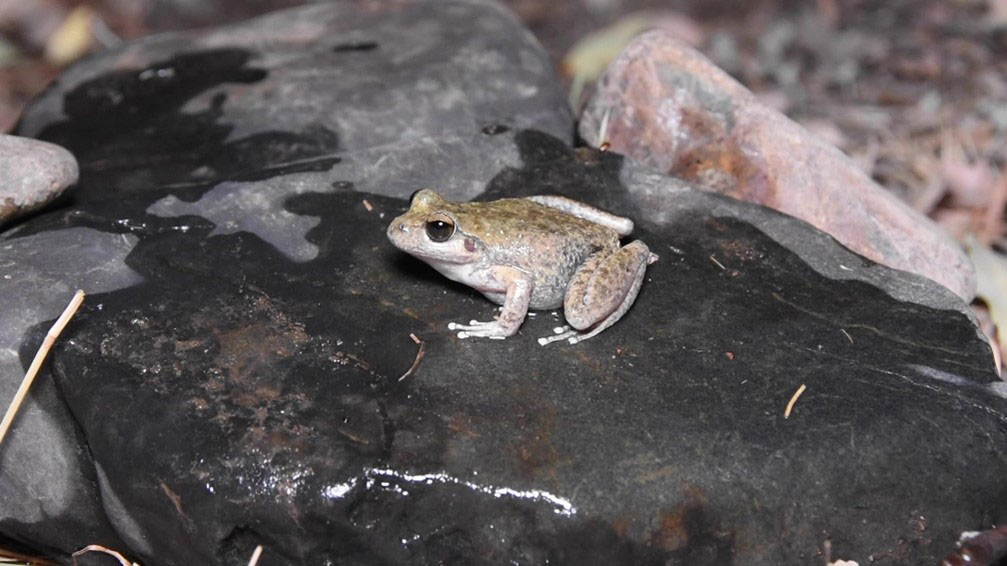Frogs
Frogs are fascinating and ecologically important creatures, playing crucial roles in maintaining the delicate balance of our ecosystems. Unfortunately, many frog species in NSW are facing significant threats, putting them at risk of extinction.
The importance of frogs in ecosystems
Frogs are considered indicator species, which means they can provide valuable insights into the overall health of ecosystems and the biodiversity they support. They are highly sensitive to environmental changes, especially in their aquatic and terrestrial habitats. As amphibians, they depend on both water and land for different life stages, making them vulnerable to a wide range of threats. Frogs also play a vital role in connecting ecosystems through their reliance on diverse waterways. They form a crucial link in the food chain as both predators of insects and prey for larger predators like birds and snakes.
Why protecting frogs matters
- Biodiversity conservation: Protecting threatened frog species is essential for maintaining biodiversity. Each species plays a specific role in the ecosystem, and their disappearance can lead to imbalances that can have far-reaching consequences for other flora and fauna.
- Ecosystem health: Healthy frog populations indicate a well-functioning ecosystem. As sensitive indicators, their presence or absence can signal potential environmental problems, allowing us to address them proactively.
- Cultural and aesthetic value: Frogs have cultural significance in many societies, including First Nations. They play a vital role in stories, myths, and artwork. Preserving these creatures ensures that future generations can appreciate and learn from their beauty and importance.
Threatened frog species in NSW
Some of the threatened / endangered frogs in NSW are:
- Booroolong Frog (Litoria booroolongensis) - this remarkable amphibian is native to the eastern highlands of Australia. This elusive frog, known for its distinctive musical call resembling a soft tinkling bell, inhabits cool, moist forested areas near streams and water bodies. With its vibrant green coloration and unique pattern of yellow spots, the Booroolong Frog is a symbol of the region's rich biodiversity. However, it faces significant challenges due to habitat loss and the spread of fungal diseases affecting amphibian populations worldwide. Conservation efforts are crucial to ensure the survival of this enchanting species and maintain the delicate ecological balance it contributes to
- Green and Golden Bell Frog (Litoria aurea) - once widespread across eastern Australia, the Green and Golden Bell Frog has experienced a sharp decline due to habitat loss and degradation. Urbanisation, pollution, and invasive species have significantly impacted its survival. Protecting and restoring its wetland habitats are vital to save this beautiful frog from disappearing entirely
- Southern Corroboree Frog (Pseudophryne corroboree) - this vibrant yellow and black frog is an iconic species native to the Snowy Mountains region. Its decline is primarily attributed to the spread of the deadly chytrid fungus, which affects amphibians worldwide. Efforts to breed and reintroduce captive-bred individuals to the wild are underway, emphasizing the importance of conserving its mountain bog habitats
- Giant Burrowing Frog (Heleioporus australiacus) - as the name suggests, the Giant Burrowing Frog is an impressive amphibian known for its burrowing abilities. However, these unique traits have not protected it from the threats of land clearing and habitat destruction. Preserving its native woodland and forest habitats is essential for its continued survival
- Red-Crowned Toadlet (Pseudophryne australis) - this tiny, brightly coloured toadlet is found in the Sydney region and faces numerous threats, including habitat loss, pollution, and disease. Conserving its natural bushland habitats and implementing strict environmental protections are necessary to safeguard its population.

Image: Booroolong frog. Photo credit Taronga Zoo
How can we protect frogs?
- Habitat preservation: protecting and restoring natural habitats, such as wetlands, forests, and bogs, is critical for the survival of threatened frog species
- Mitigating pollution: reducing pollution in water bodies and surrounding environments helps maintain suitable conditions for frog populations
- Managing invasive species: controlling the spread of invasive plants and animals that can disrupt frog habitats is crucial
- Disease monitoring: monitoring and managing diseases like chytrid fungus can help prevent large-scale population declines
- Community engagement: raising awareness and involving local communities in conservation efforts can make a significant difference in protecting threatened frog species.
Additionally, everyone can be a part of citizen science projects like Australian Museum’s Frog ID app and inaturalist app.
Frogs of the Greater Sydney region
The Frogs of the Greater Sydney Region guide PDF, 7010.51 KB aims to assist with the identification of these 40 plus native species as well as one invasive species, the cane toad (Rhinella marina). The guide is based on the publication produced by Hunter Local Land Services and has been tailored for our region with assistance from the Australian Museum. The unique First Nation’s acknowledgement was written by our own Biosecurity Support Officer, Mitchell Booty, and provides a captivating insight into the importance of frogs to First Nations peoples.
Some of the threatened / endangered species in Greater Sydney includes:
- Stuttering frog
- Giant barred frog
- Mahony’s toadlet
- Green and golden bell frog
- Northern heath frog
- Wallum froglet
To learn more about frogs in the Greater Sydney region (including the threatened species), download a digital copy of Frogs of the Greater Sydney Region guide PDF, 7010.51 KB or request a hardcopy by calling 4724 2100.
Additional information and resources:
- NSW Survey Guide for Threatened Frogs
- Frogs of Australia
- Frogs – NSW Government
- Why You Need To Be Friendly to Frogs
- Frogs of SW NSW
- Recognising Habitat Features
- Booroolong Frog and habitat in the Riverina region, pg 17 PDF, 12926.7 KB
- Frogs of the Hunter region PDF, 8366.57 KB
- Fish, Frogs, Flora and Fresh Flowing Water Project
- Frogs of the Greater Sydney Region guide PDF, 7010.51 KB